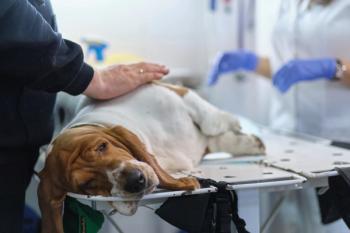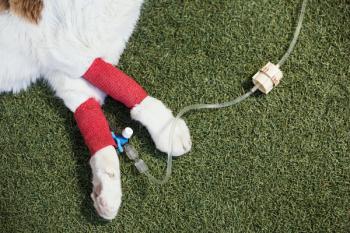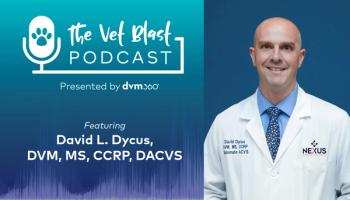
Can antibiotics make your veterinary patients fat?
Researchers discuss how manipulating the microbiome can affect obesity and other disease conditions.
Microorganisms that share the environment with humans and animals-whether symbiotic, commensal or pathogenic-are becoming an increasingly interesting subject as researchers learn more about their influence on health and disease states in the organisms with which they cohabitate. While some researchers use the term “microbiome” to refer to the collective genome of microorganisms that occupy a specific ecological niche, others use “microbiota” when defining a group of microorganisms themselves. Still others use the terms interchangeably.
Researchers may switch up their terminology, but there was much agreement at the 2014 Animal Health Research Symposium, hosted by the Kansas City Area Life Sciences Institute and held in conjunction with CVC Kansas City, that the microbiota has a major impact on human and animal health-much like that of any other organ system. The constituents of the microbiota serve many beneficial functions for the host, including pathogen displacement, immune system development, and vitamin and short chain fatty acid production.
Microbiota and the gut
A presentation by Kelly Scott Swanson, PhD, a nutritionist at the University of Illinois, looked at the impact of probiotics, prebiotics and antibiotics on the canine and feline gut microbiome. For the past 10 years Swanson has been conducting research to understand how microbes affect the health of the host and how altering the microbiome can affect certain disease states.
Studying dog and cat gut microbiomes is important from a One Health perspective because dogs and cats live in close proximity to humans, as do production livestock in many cases. In a home or on a farm, the animals and humans share microbes. And because of their close proximity to people, dogs and cats can serve as sentinels for disease. For example, Swanson expressed concern about feeding raw diets to pets because of the risk of Salmonella infection to those companion animals that eat raw food, but an even greater risk exists for immunocompromised people such as seniors or small children in the same household, he says.
In his research, Swanson uses bioinformatics tools and gene sequencing to analyze data from the gastrointestinal microbiomes of dogs and cats to look for patterns and identify relationships associated with conditions like obesity, diabetes and other metabolic diseases. He has noted that trends for such conditions in people are frequently followed by similar trends in companion animals. He also argues that conditions in companion animals such as oral disease, gastrointestinal diseases, inflammatory bowel disease, skin and urinary tract diseases, and Salmonella and Campylobacter infections are all related to changes in the animal's microbiome.
Until 2013 there wasn't much study of the relationship between these diseases and the microbiome in companion animals, but human research findings have helped investigators understand these relationships better. One challenge researchers face is the high degree of variability in the microbiomes of individual patients based on things like diet, environment and immune function, making establishing a baseline difficult.
Once the relationship of the microbiome to individual health is better understood, Swanson says, future therapeutic options could include manipulating the microbiome with diet to promote production of certain metabolites or changing the constituency of the microbiome with prebiotics and probiotics. Prebiotics are a fermentable fiber that selects for advantageous bacteria, while probiotics are microorganisms ingested in order to directly change the constituency of the gastrointestinal tract.
Antibiotics and obesity
Laura Cox, PhD, from New York University's Langone Medical Center, spoke to symposium attendees about the impact of early-life subtherapeutic antibiotic treatment on body compostion. According to Cox, a number of researchers have demonstrated that altered microbiota can actually cause obesity, whether through disruption at the intestinal interface (such as weakening of tight junctions between GI endothelial cells), a loss of the inflamasome, or a knockout of TLR5, which senses bacterial flagellum and helps control the microbiota. As a result, bacteria products can be translocated, triggering low-grade inflammation or altering metabolic signaling in the gut. All of these processes together can drive obesity, diabetes and nonalcoholic steatohepatitis.
Other research has demonstrated that antibiotic therapy disrupts early microbiota development, Cox says. Research on subtherapeutic antibiotic use in production animals for growth promotion has shown that the earlier in the animal's life this practice is started, the more profound the effect. This effect has been demonstrated across antibiotic classes with different bacterial targets but was not demonstrated by antivirals or antifungals, Cox says.
This production animal model has been replicated in mice to produce an increase in fat mass, leading Cox to explore this process further. She has demonstrated that early-infancy exposure to subtherapeutic antibiotic levels causes a shift in the composition of the microbiota, leading to an increased vulnerability to disruption. Not only did the mice in her lab gain weight, but analysis of fat composition demonstrated an increase in more metabolically active visceral fat and increases in liver adiposity. Both processes are driven by increased gene expression in genes involved in fat metabolism in the liver, clearly linking antibiotic exposure to changes in metabolic pathways. Additional research has demonstrated that even more weight gain occurs in mice when they are exposed to a high-fat diet in combination with this microbiota disruption and that changes in the metabolic pathways are sustained throughout life.
Research in mice has demonstrated that antibiotic therapy disrupts early microbiota development, leading to an increase in fat mass. The earlier in the animal's life this practice is started, the more profound the effect. Getty ImagesCox has demonstrated with her research that subtherapeutic doses of antibiotics early in life can cause changes in microbiota that result in changes in body composition, but, even more importantly, she has shown that the microbes alone can drive fat accumulation. Germ-free mice colonized with microbiota from antibiotic-treated animals gained more weight and fat than those colonized with microbiota from control mice. These studies have been recently published (see the August 14 issue of Cell), and Cox is currently investigating the roles of specific bacteria in shaping development and obesity.
Further research is needed for scientists and practitioners to understand exactly how subtherapeutic antibiotics early in life impact the microbiota and metabolic pathways, producing obesity in humans and animals. But once they do, new therapeutic interventions may be possible-perhaps using prebiotic and probiotic therapies-and policymakers could take a smarter smarter approach to regulating antibiotic use.
According to these and other researchers who spoke at the symposium, the solution to combating bacterial diseases is not developing newer generations of antibiotics. Future management of bacterial diseases will focus on prevention of disease using prebiotics, probiotics, nanotechnology, immunotherapies-and agents for which the Food and Drug Administration currently has no approval process.
Dr. Suzanne Parsel is owner of
Newsletter
From exam room tips to practice management insights, get trusted veterinary news delivered straight to your inbox—subscribe to dvm360.





